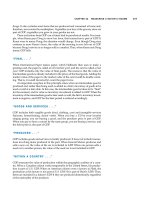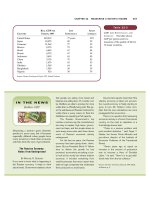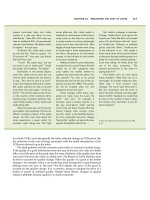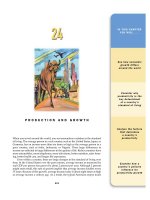Ten Principles of Economics - Part 1
Bạn đang xem bản rút gọn của tài liệu. Xem và tải ngay bản đầy đủ của tài liệu tại đây (227.66 KB, 10 trang )
IN THIS CHAPTER
YOU WILL . . .
Discuss how
incentives affect
people’s behavior
Learn the meaning of
opportunity cost
Learn that
economics is about
the allocation of
scarce resources
Examine some of the
tradeoffs that people
face
See how to use
marginal reasoning
when making
decisions
The word economy comes from the Greek word for “one who manages a house-
hold.” At first, this origin might seem peculiar. But, in fact, households and
economies have much in common.
A household faces many decisions. It must decide which members of the
household do which tasks and what each member gets in return: Who cooks din-
ner? Who does the laundry? Who gets the extra dessert at dinner? Who gets to
choose what TV show to watch? In short, the household must allocate its scarce re-
sources among its various members, taking into account each member’s abilities,
efforts, and desires.
Like a household, a society faces many decisions. A society must decide what
jobs will be done and who will do them. It needs some people to grow food, other
people to make clothing, and still others to design computer software. Once soci-
ety has allocated people (as well as land, buildings, and machines) to various jobs,
TEN PRINCIPLES
OF ECONOMICS
3
Consider why trade
among people or
nations can be good
for everyone
Discuss why markets
are a good, but not
perfect, way to
allocate resources
Learn what
determines some
trends in the overall
economy
4 PART ONE INTRODUCTION
it must also allocate the output of goods and services that they produce. It must
decide who will eat caviar and who will eat potatoes. It must decide who will
drive a Porsche and who will take the bus.
The management of society’s resources is important because resources are
scarce. Scarcity means that society has limited resources and therefore cannot pro-
duce all the goods and services people wish to have. Just as a household cannot
give every member everything he or she wants, a society cannot give every indi-
vidual the highest standard of living to which he or she might aspire.
Economics is the study of how society manages its scarce resources. In most
societies, resources are allocated not by a single central planner but through the
combined actions of millions of households and firms. Economists therefore study
how people make decisions: how much they work, what they buy, how much they
save, and how they invest their savings. Economists also study how people inter-
act with one another. For instance, they examine how the multitude of buyers and
sellers of a good together determine the price at which the good is sold and the
quantity that is sold. Finally, economists analyze forces and trends that affect
the economy as a whole, including the growth in average income, the fraction of
the population that cannot find work, and the rate at which prices are rising.
Although the study of economics has many facets, the field is unified by sev-
eral central ideas. In the rest of this chapter, we look at Ten Principles of Economics.
These principles recur throughout this book and are introduced here to give you
an overview of what economics is all about. You can think of this chapter as a “pre-
view of coming attractions.”
HOW PEOPLE MAKE DECISIONS
There is no mystery to what an “economy” is. Whether we are talking about the
economy of Los Angeles, of the United States, or of the whole world, an economy
is just a group of people interacting with one another as they go about their lives.
Because the behavior of an economy reflects the behavior of the individuals who
make up the economy, we start our study of economics with four principles of in-
dividual decisionmaking.
PRINCIPLE #1: PEOPLE FACE TRADEOFFS
The first lesson about making decisions is summarized in the adage: “There is no
such thing as a free lunch.” To get one thing that we like, we usually have to give
up another thing that we like. Making decisions requires trading off one goal
against another.
Consider a student who must decide how to allocate her most valuable re-
source—her time. She can spend all of her time studying economics; she can spend
all of her time studying psychology; or she can divide her time between the two
fields. For every hour she studies one subject, she gives up an hour she could have
used studying the other. And for every hour she spends studying, she gives up an
hour that she could have spent napping, bike riding, watching TV, or working at
her part-time job for some extra spending money.
scarcity
the limited nature of society’s
resources
economics
the study of how society manages its
scarce resources
CHAPTER 1 TEN PRINCIPLES OF ECONOMICS 5
Or consider parents deciding how to spend their family income. They can buy
food, clothing, or a family vacation. Or they can save some of the family income
for retirement or the children’s college education. When they choose to spend an
extra dollar on one of these goods, they have one less dollar to spend on some
other good.
When people are grouped into societies, they face different kinds of tradeoffs.
The classic tradeoff is between “guns and butter.” The more we spend on national
defense to protect our shores from foreign aggressors (guns), the less we can spend
on consumer goods to raise our standard of living at home (butter). Also important
in modern society is the tradeoff between a clean environment and a high level of
income. Laws that require firms to reduce pollution raise the cost of producing
goods and services. Because of the higher costs, these firms end up earning smaller
profits, paying lower wages, charging higher prices, or some combination of these
three. Thus, while pollution regulations give us the benefit of a cleaner environ-
ment and the improved health that comes with it, they have the cost of reducing
the incomes of the firms’ owners, workers, and customers.
Another tradeoff society faces is between efficiency and equity. Efficiency
means that society is getting the most it can from its scarce resources. Equity
means that the benefits of those resources are distributed fairly among society’s
members. In other words, efficiency refers to the size of the economic pie, and
equity refers to how the pie is divided. Often, when government policies are being
designed, these two goals conflict.
Consider, for instance, policies aimed at achieving a more equal distribution of
economic well-being. Some of these policies, such as the welfare system or unem-
ployment insurance, try to help those members of society who are most in need.
Others, such as the individual income tax, ask the financially successful to con-
tribute more than others to support the government. Although these policies have
the benefit of achieving greater equity, they have a cost in terms of reduced effi-
ciency. When the government redistributes income from the rich to the poor, it re-
duces the reward for working hard; as a result, people work less and produce
fewer goods and services. In other words, when the government tries to cut the
economic pie into more equal slices, the pie gets smaller.
Recognizing that people face tradeoffs does not by itself tell us what decisions
they will or should make. A student should not abandon the study of psychology
just because doing so would increase the time available for the study of econom-
ics. Society should not stop protecting the environment just because environmen-
tal regulations reduce our material standard of living. The poor should not be
ignored just because helping them distorts work incentives. Nonetheless, ac-
knowledging life’s tradeoffs is important because people are likely to make good
decisions only if they understand the options that they have available.
PRINCIPLE #2: THE COST OF SOMETHING IS
WHAT YOU GIVE UP TO GET IT
Because people face tradeoffs, making decisions requires comparing the costs and
benefits of alternative courses of action. In many cases, however, the cost of some
action is not as obvious as it might first appear.
Consider, for example, the decision whether to go to college. The benefit is in-
tellectual enrichment and a lifetime of better job opportunities. But what is the
cost? To answer this question, you might be tempted to add up the money you
efficiency
the property of society getting the
most it can from its scarce resources
equity
the property of distributing economic
prosperity fairly among the members
of society
6 PART ONE INTRODUCTION
spend on tuition, books, room, and board. Yet this total does not truly represent
what you give up to spend a year in college.
The first problem with this answer is that it includes some things that are not
really costs of going to college. Even if you quit school, you would need a place to
sleep and food to eat. Room and board are costs of going to college only to the ex-
tent that they are more expensive at college than elsewhere. Indeed, the cost of
room and board at your school might be less than the rent and food expenses that
you would pay living on your own. In this case, the savings on room and board
are a benefit of going to college.
The second problem with this calculation of costs is that it ignores the largest
cost of going to college—your time. When you spend a year listening to lectures,
reading textbooks, and writing papers, you cannot spend that time working at a
job. For most students, the wages given up to attend school are the largest single
cost of their education.
The opportunity cost of an item is what you give up to get that item. When
making any decision, such as whether to attend college, decisionmakers should be
aware of the opportunity costs that accompany each possible action. In fact, they
usually are. College-age athletes who can earn millions if they drop out of school
and play professional sports are well aware that their opportunity cost of college
is very high. It is not surprising that they often decide that the benefit is not worth
the cost.
PRINCIPLE #3: RATIONAL PEOPLE THINK AT THE MARGIN
Decisions in life are rarely black and white but usually involve shades of gray.
When it’s time for dinner, the decision you face is not between fasting or eating
like a pig, but whether to take that extra spoonful of mashed potatoes. When ex-
ams roll around, your decision is not between blowing them off or studying 24
hours a day, but whether to spend an extra hour reviewing your notes instead of
watching TV. Economists use the term marginal changes to describe small incre-
mental adjustments to an existing plan of action. Keep in mind that “margin”
means “edge,” so marginal changes are adjustments around the edges of what you
are doing.
In many situations, people make the best decisions by thinking at the margin.
Suppose, for instance, that you asked a friend for advice about how many years to
stay in school. If he were to compare for you the lifestyle of a person with a Ph.D.
to that of a grade school dropout, you might complain that this comparison is not
helpful for your decision. You have some education already and most likely are
deciding whether to spend an extra year or two in school. To make this decision,
you need to know the additional benefits that an extra year in school would offer
(higher wages throughout life and the sheer joy of learning) and the additional
costs that you would incur (tuition and the forgone wages while you’re in school).
By comparing these marginal benefits and marginal costs, you can evaluate whether
the extra year is worthwhile.
As another example, consider an airline deciding how much to charge passen-
gers who fly standby. Suppose that flying a 200-seat plane across the country costs
the airline $100,000. In this case, the average cost of each seat is $100,000/200,
which is $500. One might be tempted to conclude that the airline should never
sell a ticket for less than $500. In fact, however, the airline can raise its profits by
opportunity cost
whatever must be given up to obtain
some item
marginal changes
small incremental adjustments to a
plan of action
CHAPTER 1 TEN PRINCIPLES OF ECONOMICS 7
thinking at the margin. Imagine that a plane is about to take off with ten empty
seats, and a standby passenger is waiting at the gate willing to pay $300 for a seat.
Should the airline sell it to him? Of course it should. If the plane has empty seats,
the cost of adding one more passenger is minuscule. Although the average cost of
flying a passenger is $500, the marginal cost is merely the cost of the bag of peanuts
and can of soda that the extra passenger will consume. As long as the standby pas-
senger pays more than the marginal cost, selling him a ticket is profitable.
As these examples show, individuals and firms can make better decisions by
thinking at the margin. A rational decisionmaker takes an action if and only if the
marginal benefit of the action exceeds the marginal cost.
PRINCIPLE #4: PEOPLE RESPOND TO INCENTIVES
Because people make decisions by comparing costs and benefits, their behavior
may change when the costs or benefits change. That is, people respond to incen-
tives. When the price of an apple rises, for instance, people decide to eat more
pears and fewer apples, because the cost of buying an apple is higher. At the same
time, apple orchards decide to hire more workers and harvest more apples, be-
cause the benefit of selling an apple is also higher. As we will see, the effect of price
on the behavior of buyers and sellers in a market—in this case, the market for
apples—is crucial for understanding how the economy works.
Public policymakers should never forget about incentives, for many policies
change the costs or benefits that people face and, therefore, alter behavior. A tax on
gasoline, for instance, encourages people to drive smaller, more fuel-efficient cars.
It also encourages people to take public transportation rather than drive and to
live closer to where they work. If the tax were large enough, people would start
driving electric cars.
When policymakers fail to consider how their policies affect incentives, they
can end up with results that they did not intend. For example, consider public pol-
icy regarding auto safety. Today all cars have seat belts, but that was not true 40
years ago. In the late 1960s, Ralph Nader’s book Unsafe at Any Speed generated
much public concern over auto safety. Congress responded with laws requiring car
companies to make various safety features, including seat belts, standard equip-
ment on all new cars.
How does a seat belt law affect auto safety? The direct effect is obvious. With
seat belts in all cars, more people wear seat belts, and the probability of surviving
a major auto accident rises. In this sense, seat belts save lives.
But that’s not the end of the story. To fully understand the effects of this law,
we must recognize that people change their behavior in response to the incentives
they face. The relevant behavior here is the speed and care with which drivers op-
erate their cars. Driving slowly and carefully is costly because it uses the driver’s
time and energy. When deciding how safely to drive, rational people compare the
marginal benefit from safer driving to the marginal cost. They drive more slowly
and carefully when the benefit of increased safety is high. This explains why peo-
ple drive more slowly and carefully when roads are icy than when roads are clear.
Now consider how a seat belt law alters the cost–benefit calculation of a ratio-
nal driver. Seat belts make accidents less costly for a driver because they reduce
the probability of injury or death. Thus, a seat belt law reduces the benefits to slow
and careful driving. People respond to seat belts as they would to an improvement
B
ASKETBALL STAR
K
OBE
B
RYANT
UNDERSTANDS OPPORTUNITY COST AND
INCENTIVES
. D
ESPITE GOOD HIGH SCHOOL
GRADES AND
SAT
SCORES
,
HE DECIDED
TO SKIP COLLEGE AND GO STRAIGHT TO
THE
NBA,
WHERE HE EARNED ABOUT
$10
MILLION OVER FOUR YEARS
.









